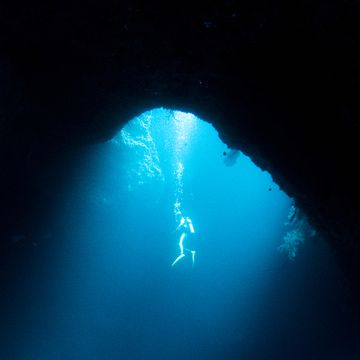- A new paper calculates the propulsive pressure of penguin waste.
- Penguins must expel waste a long way while protecting their young in the nest.
- Next, do sloths.
In 2020, Americans have learned a lot about fluid dynamics, such as the way our breath droplets spray through the air when we're not wearing a protective mask. But scientists hope you have some room in your heart to think about a very different kind of fluid: penguin poo.
In a new study, researchers revisit an Ignobel-winning 2003 paper about the physics of penguin feces. The new research is on arXiv, but it hasn’t been reviewed or accepted for publication yet, presumably because all other scientists are cowards. Hiroyuki Tajima and Fumiya Fujisawa, from Japan’s Kochi University and the Katsurahama Aquarium, collaborated on “Projectile Trajectory of Penguin’s Faeces and Rectal Pressure Revisited.” They explain their findings:
“The flying distance of penguin’s faeces reaches about 0.4 m even on the ground. Since a typical height of a Humboldt penguin is given by 0.4 m, this distance corresponds to the situation that if a human being whose height is 1.7 m tries to evacuate his/her bowels, the object could fly to 1.7 m away. Therefore, one can immediately understand that [a] penguin’s rectal pressure is relatively much [stronger] compared to that of a human.”
That means for a human to have the backdoor thrust of a penguin, they’d need to be able to propel waste matter almost 6 feet away. And using this baseline for a penguin on the ground, the scientists extend the 2003 paper into a new analysis of what happens when a penguin on higher ground, like from the edge of a cliff, releases waste from a greater height:
“In the presence of the viscous resistance, the grounding time and the flying distance of faeces can be expressed in terms of Lambert W function. Furthermore, we address the penguin’s rectal pressure within the hydrodynamical approximation combining Bernoulli’s theorem and Hagen-Poiseuille equation for viscosity corrections.”
The Lambert W function is also known as the “product logarithm,” producing a log-y curve that mathematically models a lot of phenomena from physics. The 2003 paper didn’t use a W function and stuck with the Hagen-Poiseuille equation, so the new model purports to be more accurate and precise especially from a greater height.
Tajima and Fujisawa conclude that the expulsion pressure of the waste is indeed higher than that calculated in the previous study. (The two papers also study different kinds of penguins, for what it's worth: chinstrap and Adelie penguins for the 2003 paper and Humboldt penguins for the new research.)
The researchers stress this is interesting work with a hook for further exploration, but at the same time, they understand it’s a showy and fun example for introductory physics.
“We expect that our results would also be a useful example for teaching classical mechanics in the undergraduate course. One can recognize that fundamental physics and mathematics we learn in schools describe interesting aspects of various things surrounding our daily life.”

Caroline Delbert is a writer, avid reader, and contributing editor at Pop Mech. She's also an enthusiast of just about everything. Her favorite topics include nuclear energy, cosmology, math of everyday things, and the philosophy of it all.














